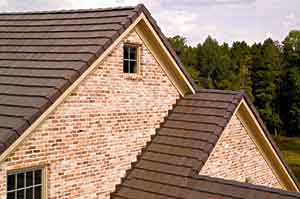Concrete Tiles: Durable, Sustainable Roofing Materials Integrate Design and Performance
Learning Objectives:
- Understand the qualities and design criteria for use of concrete tiles.
- Identify how climate conditions and code requirements impact the use of concrete tile roofs.
- Learn why concrete tile is considered an energy efficient and sustainable material.
- Analyze the structural issues relating to concrete tile applications.
- Explain how coloring and efflorescence affect use of concrete tile.
Credits:
Concrete roof tile, used for centuries, is a dependable, durable, and sustainable material that enhances energy efficient design, while exhibiting a distinct architectural character. In recent years, the material has grown in popularity because of its superior strength compared to other traditional roofing materials, like wood or asphalt.
Because of concrete tile's long history, a large number of roof tile shapes have been developed. There are flat tiles, Roman tiles with a concave curve at one end and a convex curve at the other (to allow interlocking), S-shaped pan tiles, and semi-cylindrical Mission or barrel tiles. It is red-hued tile that most often comes to mind with concrete tile, but the material is actually available in a variety of shapes, designs, and colors. Whether for a Craftsman bungalow, Spanish colonial, Cape Cod, or Queen Anne home, this material is suitable for many types of residential styles. Concrete roof tile is also appropriate for commercial structures, schools, churches, and other building types, because of its durability and aesthetic design qualities.
Concrete roof tiles better insulate a building against summer heat than comparable roofing products, such as asphalt or wood shingles, and have a lifespan that's often two or even three times longer. During project budgeting, life cycle costs are often evaluated against initial costs.
A multi-year span of historically low interest rates during the late 1990's through 2005 has generated a boom in residential design and construction. Homebuilders have found by using quality materials, such as concrete tile, they can add to value to their projects, and distinguish them from other countless subdivisions. "Tile roofs have such a rich heritage, appreciated by today's homeowner who is interested in craftsmanship and permanence," says Donald A. Gardner, AIA, founder, Donald A. Gardner Architects, Greenville, South Carolina. "Concrete tile meets these objectives by providing a durable roofing solution that emulates natural materials."
|
Architects and design professionals should be aware of the required conditions sometimes resulting from the additional weight of concrete roof tiles, and the potential structural loads to be accommodated on each project. Although in many cases a roof can accommodate concrete tile without any corresponding structural adjustment, it is important that proper weight measurements be made before proceeding with installation.










